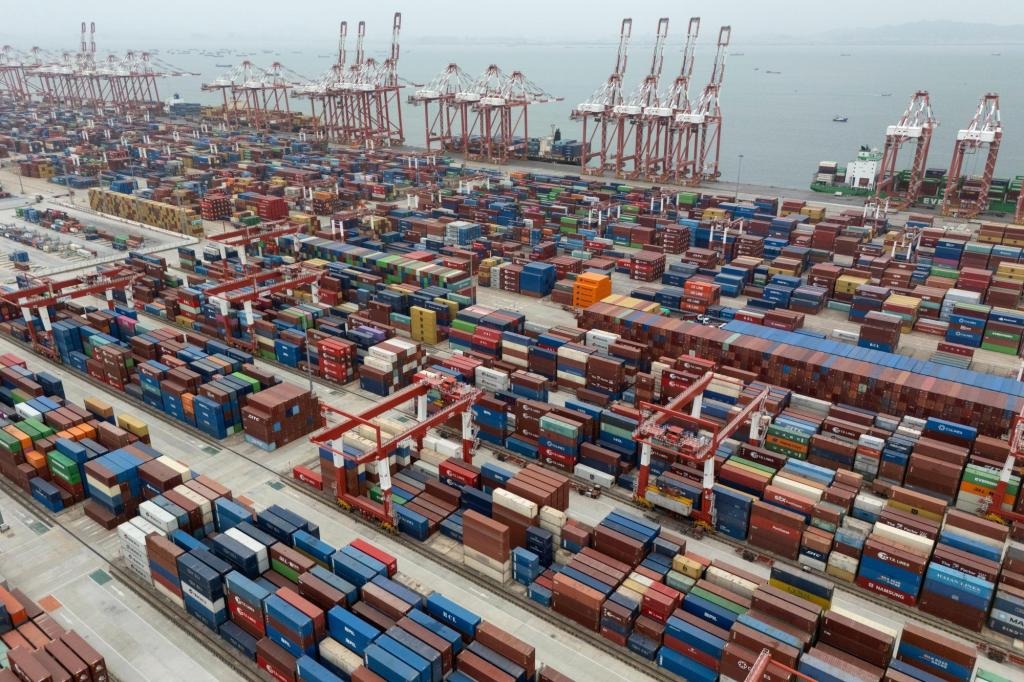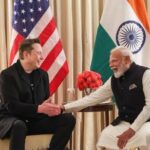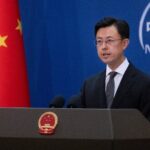Economic uncertainty grows as new administration’s trade policies begin to reshape global supply chains and impact domestic markets
Introduction
The specter of President Donald Trump’s promised tariff regime is already casting a long shadow over the U.S. economy, with early data showing a significant decline in shipments from China as businesses scramble to adjust to the new trade reality. Following his January 2025 inauguration, President Trump wasted no time signaling his administration’s intent to follow through on campaign promises of implementing substantial tariffs on imported goods, with a particular focus on products from China.
This comprehensive analysis examines the early economic impacts of these policies, the strategic repositioning by businesses on both sides of the Pacific, the broader implications for global trade patterns, and the potential long-term consequences for American consumers and industries. As shipping data reveals a marked decrease in Chinese imports and supply chain disruptions begin to emerge, economists, business leaders, and policymakers are debating whether these trade measures will achieve their stated goals of revitalizing American manufacturing or instead trigger inflation and economic contraction.
The New Tariff Landscape
Trump’s Trade Policy Vision
President Trump’s second administration has prioritized what it describes as “economic nationalism,” centered around aggressive trade policies designed to reduce America’s trade deficit, particularly with China. During his campaign, Trump repeatedly promised tariffs as high as 60% on Chinese goods and at least 10% on imports from all other countries, describing them as necessary measures to protect American jobs and manufacturing.
“We’re going to bring back American jobs, American wealth, and American factories through the power of tariffs and smart trade policy,” Trump declared during his inaugural address. “The days of America being taken advantage of in global trade are over.”
Within weeks of taking office, the administration began laying the groundwork for implementing these promises, with the Office of the U.S. Trade Representative (USTR) initiating reviews of existing trade agreements and preparing proposals for new tariff structures.
Current Implementation Status
While the full tariff package has not yet been fully implemented, the administration has taken several concrete steps that signal its seriousness about this policy direction:
- Executive Action: President Trump signed an executive order directing federal agencies to prepare for the implementation of broad-based tariffs, particularly targeting strategic goods from China.
- USTR Directives: The USTR has issued preliminary guidance on categories of goods that will face heightened tariffs, with particular emphasis on electronics, industrial components, and consumer goods from China.
- Selective Early Implementation: Some targeted tariff increases have already been implemented on specific categories of Chinese imports, serving as a precursor to the broader planned tariff regime.
- Congressional Coordination: The administration has engaged with congressional allies to prepare potential legislation that would provide statutory backing for the broader tariff plan, though this remains in early stages.
Economic advisor to the President, Larry Kudlow, explained the administration’s approach: “We’re implementing these measures in a strategic, phased manner to give American businesses time to adjust their supply chains while still sending a clear message to our trading partners that the status quo is changing.”
Early Economic Impacts
Decline in Chinese Shipments
The most immediate visible impact has been a significant drop in shipping volume from China to the United States. According to data from major shipping analytics firms, container volume from Chinese ports to U.S. destinations decreased by approximately 18% in the first quarter of 2025 compared to the same period last year.
“We’re seeing an unprecedented drop in forward bookings for trans-Pacific shipments,” noted Jonathan Roach, senior analyst at Braemar Shipping Services. “Many importers are holding back on new orders while they assess the impact of the tariff situation.”
The Port of Los Angeles, which handles approximately 20% of all incoming cargo to the United States, reported a 22% year-over-year decline in container imports from China in March 2025. Similar patterns have been observed at other major U.S. ports, including Long Beach, New York/New Jersey, and Savannah.
Market Response and Business Strategies
The looming tariffs have triggered diverse responses from businesses across different sectors:
- Accelerated Inventory Building: Some retailers and manufacturers rapidly increased their Chinese imports in late 2024 and early 2025, attempting to build inventory before tariffs took full effect.
- Supply Chain Diversification: Many companies have accelerated efforts to diversify their supply chains away from China, with countries like Vietnam, Mexico, India, and Thailand seeing increased manufacturing interest.
- Price Hedging Strategies: Businesses with exposure to affected imports have implemented various hedging strategies, including longer-term contracts with suppliers and financial instruments designed to mitigate price volatility.
- Domestic Investment Reconsideration: Some manufacturers have announced reconsideration of domestic investment plans, though concrete shifts in manufacturing location remain limited at this early stage.
A survey by the U.S. Chamber of Commerce found that 78% of companies with significant exposure to Chinese imports are actively developing contingency plans for different tariff scenarios, with 43% already implementing concrete changes to their supply chains.
Consumer Price Effects
While it’s still early to measure the full impact on consumer prices, preliminary data suggests price pressures are beginning to build in certain sectors:
- Electronics and Consumer Goods: Retailers have reported wholesale price increases of 5-12% on electronics and consumer goods with significant Chinese components, though not all of these increases have been passed on to consumers yet.
- Automotive Sector: Car manufacturers have indicated that parts shortages and price increases may add between $800 and $1,500 to the cost of vehicles if current trends continue.
- Apparel and Footwear: Industry associations report that apparel and footwear importers are facing average cost increases of 8-15% on affected product categories.
“We’re already seeing suppliers adjusting their pricing in anticipation of tariffs, even before they’re fully implemented,” explained Katherine Tai, former USTR who now works as a consultant. “This forward pricing behavior means consumers often feel effects before the policies are fully in place.”
The Federal Reserve Bank of New York’s inflation expectations survey showed that consumer expectations for inflation over the next year increased by 0.6 percentage points following the first announcements of the tariff plans, suggesting psychological impacts on spending and saving behavior.
Global Supply Chain Restructuring
China’s Response and Adaptation
The Chinese government and businesses have not remained passive in the face of these developments. Beijing has pursued a multi-faceted strategy:
- Diplomatic Engagement: Chinese officials have engaged in quiet diplomacy with U.S. counterparts, seeking to moderate the scope and implementation timeline of the tariffs.
- Currency Policy: The People’s Bank of China has allowed modest depreciation of the yuan against the dollar, partially offsetting the price impact of tariffs for U.S. importers.
- Support for Affected Industries: The Chinese government has implemented targeted support measures for export sectors facing the greatest impact, including tax rebates and financing assistance.
- Market Diversification: Chinese manufacturers have accelerated efforts to develop markets outside the United States, with particular focus on Europe, Southeast Asia, and Belt and Road Initiative countries.
Li Wei, economist at the China Center for International Economic Exchanges, noted: “Chinese companies learned important lessons from the first round of trade tensions under the previous Trump administration. This time, they’re moving much more quickly to adapt their business models and find alternative markets.”
Emerging Alternative Supply Chains
As businesses seek alternatives to Chinese manufacturing, several patterns are emerging:
- Near-Shoring to Mexico: Mexico has seen a significant uptick in manufacturing interest, particularly in sectors like automotive, electronics, and household goods. Mexican exports to the U.S. increased by 9% in the first quarter of 2025.
- Southeast Asian Manufacturing Hubs: Vietnam, Thailand, Malaysia, and Indonesia have all reported increased foreign direct investment in manufacturing capacity, particularly from companies seeking to maintain Asian supply chain integration while avoiding Chinese origin for products.
- Reshoring Challenges: Despite political rhetoric about manufacturing returning to the United States, actual reshoring has been limited by labor cost differentials, skills gaps, and infrastructure constraints. Where reshoring is occurring, it tends to be in highly automated production that creates fewer jobs than traditional manufacturing.
- India’s Manufacturing Push: India has positioned itself as a major alternative to China, with its “Make in India” initiative gaining traction among international manufacturers. However, infrastructure limitations and regulatory complexity continue to moderate the pace of manufacturing shifts to India.
A report by consulting firm McKinsey & Company estimates that approximately $120-150 billion in manufacturing capacity could shift out of China over the next five years if current tariff policies persist, with Mexico and Vietnam as the largest beneficiaries.
Logistics Industry Disruption
The shifting trade patterns have created significant disruption in the logistics industry:
- Shipping Route Adjustments: Major shipping lines have announced adjustments to their trans-Pacific routes, with some reducing capacity between China and the U.S. while increasing service to alternative manufacturing centers.
- Port Infrastructure Stress: Ports serving emerging manufacturing hubs are experiencing capacity constraints as volume shifts faster than infrastructure can adapt. Ports in Vietnam and Mexico have reported congestion and delays as shipment volumes surge.
- Freight Rate Volatility: Shipping rates have shown unusual volatility, with rates on China-U.S. routes initially dropping due to reduced demand, while rates from alternative origins to the U.S. have increased substantially.
- Longer Lead Times: Supply chain managers report increasing lead times for products as new suppliers and logistics channels are established, with typical increases of 20-40% in delivery timeframes.
“The global logistics network is essentially being rewired in real-time,” explained Soren Skou, former CEO of Maersk and current logistics industry analyst. “This creates both inefficiencies and opportunities as the system adjusts to new trade flows.”
Economic Implications for the United States
Manufacturing Sector Response
The American manufacturing sector has shown mixed responses to the evolving trade situation:
- Steel and Aluminum: Domestic producers of steel and aluminum have announced plans to increase capacity utilization and hiring, citing improved competitive position due to tariffs on foreign materials.
- Electronics and Consumer Goods: U.S. manufacturers in these sectors report challenging conditions as they grapple with higher component costs while still facing competition from finished goods imports from countries not subject to the highest tariffs.
- Pharmaceutical and Medical Supplies: Following supply chain vulnerabilities exposed during the COVID-19 pandemic, pharmaceutical manufacturers have accelerated domestic production capacity for critical medicines and supplies, a trend reinforced by the current trade environment.
- Agricultural Sector Concerns: American agricultural exporters have expressed concern about potential retaliatory measures from China that could impact their exports, particularly soybeans, pork, and other commodity crops.
The Institute for Supply Management’s manufacturing index declined by 3.2 points in April 2025, with survey respondents frequently citing trade policy uncertainty and input cost increases as major concerns.
Labor Market Effects
Early labor market data shows a complex picture of the tariffs’ employment impact:
- Manufacturing Employment: Manufacturing sectors directly protected by tariffs, particularly primary metals, have reported modest employment increases of 2-3% since the beginning of 2025.
- Retail and Distribution: Retail and distribution sectors have shown early signs of employment contraction, with major retailers implementing hiring freezes or modest layoffs citing margin pressures and demand uncertainty.
- Logistics Sector Shifts: While some logistics jobs focused on China trade have been affected negatively, new positions are emerging in supply chain redesign, compliance, and management of more complex sourcing strategies.
- Regional Variations: The employment impacts show significant regional variation, with manufacturing-heavy regions in the Midwest seeing modest job gains while coastal areas more dependent on trade and distribution report early job losses.
“What we’re seeing is not so much net job creation or destruction yet, but rather a reshuffling of employment across sectors and regions,” noted Erica Groshen, former Commissioner of the Bureau of Labor Statistics. “The full employment impact will depend on how persistent these policies are and how completely businesses adjust their operations in response.”
Inflation Concerns
The Federal Reserve and private economists have expressed increasing concern about the inflationary potential of broad tariffs:
- Direct Price Effects: The Federal Reserve Bank of San Francisco estimates that full implementation of the proposed tariff package could add between 0.8 and 1.2 percentage points to core inflation in the first year.
- Supply Chain Inefficiencies: Beyond direct price impacts, the inefficiencies created by rapid supply chain restructuring may add additional inflationary pressure through increased logistics costs and production delays.
- Monetary Policy Implications: Financial markets are increasingly pricing in expectations that the Federal Reserve may need to maintain higher interest rates for longer to counter tariff-induced inflation, potentially constraining economic growth.
- Wage-Price Spiral Risks: Some economists have raised concerns that inflationary pressures could trigger demands for compensating wage increases, potentially creating a wage-price spiral that would be difficult to control without significant monetary tightening.
Fed Chair Jerome Powell addressed these concerns in recent Congressional testimony: “We are closely monitoring the potential inflationary impact of trade policy changes. While some price effects are inevitable with significant tariffs, our mandate remains price stability, and we will adjust monetary policy as needed to maintain that stability.”
Political Dimensions and Policy Debates
Domestic Political Landscape
The tariff policies have reshaped political alignments in Washington:
- Congressional Reactions: The response in Congress has not followed strict party lines, with some traditional Republican free-traders expressing concern while some Democrats from manufacturing-heavy districts voicing support.
- Business Community Division: The business community has shown unusual fragmentation, with import-dependent retailers and technology firms opposing the tariffs while some domestic manufacturers express support.
- Labor Union Positioning: Major labor unions have generally supported the tariff measures while expressing concern about potential inflation impacts on their members’ purchasing power.
- Public Opinion Dynamics: Polling shows the American public remains divided on the tariffs, with 46% expressing support, 42% opposition, and 12% undecided according to recent Gallup data.
Political analyst Amy Walter of the Cook Political Report noted: “The tariff issue has scrambled traditional political coalitions. We’re seeing unusual alliances forming and traditional allies finding themselves on opposite sides of the debate.”
Policy Alternatives and Modifications
As economic data continues to emerge, various stakeholders have proposed modifications to the tariff approach:
- Targeted Approach Advocates: Some business groups and economists have advocated for more narrowly targeted tariffs focused on strategic industries rather than broad-based measures.
- Sunset Provisions: Legislative proposals have emerged to include automatic sunset provisions for the tariffs, requiring periodic review and renewal rather than indefinite implementation.
- Complementary Policies: Policy experts have emphasized the need for complementary domestic policies to maximize any potential benefits from tariffs, including workforce development, infrastructure investment, and R&D support.
- International Coordination: Foreign policy specialists have suggested coordinating tariff policies with allies to create more effective pressure on China regarding specific trade practices of concern.
Former U.S. Treasury Secretary Lawrence Summers articulated a middle position that has gained traction among some policy experts: “Targeted tariffs addressing specific unfair trade practices may have a role in a comprehensive economic strategy, but broad-based tariffs risk significant collateral damage to our own economy without achieving their stated objectives.”
International Relations and Global Trade System
Bilateral U.S.-China Relations
The tariff measures have contributed to further cooling of U.S.-China relations across multiple dimensions:
- Diplomatic Engagement: High-level economic dialogues between the countries have been reduced, with Chinese officials canceling several planned visits following the tariff announcements.
- Strategic Competition Framing: Both governments have increasingly framed economic policies within a broader narrative of strategic competition, reducing the space for pragmatic compromise.
- Technology Sector Focus: Particular tension has emerged around technology-related trade, with additional restrictions being considered on both sides for semiconductor, telecommunications, and advanced computing technologies.
- Military Tensions: Economic tensions have coincided with increased military posturing in the South China Sea and around Taiwan, though direct linkage between trade and security issues remains ambiguous.
Former U.S. Ambassador to China, Terry Branstad, observed: “Economic tension inevitably spills over into other aspects of the relationship. The challenge is to establish guardrails that prevent trade disputes from undermining cooperation on issues like climate change and regional security.”
WTO and Global Trading System
The tariff measures have raised fundamental questions about the future of the global trading system:
- WTO Challenge Likelihood: China and other affected countries have indicated they are preparing formal challenges to the U.S. tariffs through the World Trade Organization’s dispute settlement system.
- Dispute Resolution Mechanism: The already-strained WTO dispute resolution mechanism faces further pressure, with questions about its capacity to address major power trade conflicts effectively.
- Precedent Effects: Other countries are watching closely to determine whether they should pursue similar protectionist measures, potentially threatening the rules-based trading system established over recent decades.
- Regional Trade Agreement Dynamics: Interest in regional trade agreements that exclude either the U.S. or China has increased, potentially accelerating the fragmentation of global trade into competing blocs.
WTO Director-General Ngozi Okonjo-Iweala expressed concern in a recent statement: “Unilateral tariff measures outside our agreed frameworks risk undermining the multilateral trading system that has supported global prosperity for generations. We urge all members to address trade concerns through established WTO mechanisms.”
Looking Ahead: Scenarios and Projections
Short-Term Outlook
Economic forecasters have developed several scenarios for the coming 12-18 months:
- Baseline Scenario: Most economists project modestly higher inflation (0.7-1.0 percentage points above baseline), slower GDP growth (0.3-0.5 percentage points below baseline), and continued supply chain disruption through the remainder of 2025.
- Escalation Scenario: If trade tensions escalate into broader reciprocal tariffs and non-tariff barriers, more significant economic impacts could emerge, including potential GDP contraction and inflation exceeding 4%.
- Negotiated Moderation: Some analysts predict that economic pain will eventually lead to negotiated moderation of the tariff measures, potentially in conjunction with targeted agreements on specific Chinese trade practices.
The Congressional Budget Office has adjusted its economic projections to account for the tariff measures, reducing projected GDP growth for 2025 from 2.2% to 1.8% while increasing its inflation forecast.
Long-Term Structural Implications
Beyond immediate economic impacts, analysts are considering longer-term structural changes that may emerge:
- Manufacturing Reshoring Realities: Realistic assessments suggest that while some manufacturing may return to the U.S., much production will shift to other low-cost countries rather than reshoring, creating a more diversified but still globalized manufacturing landscape.
- Innovation and Productivity Effects: Higher input costs and market fragmentation may impact innovation trajectories and productivity growth, with particular concern for sectors reliant on global R&D collaboration.
- Dollar Dominance Questions: Some international economists have raised questions about whether trade fragmentation could eventually challenge the dollar’s dominant position in international trade and finance.
- Environmental Considerations: Supply chain restructuring may have significant environmental implications, both positive (shorter shipping distances in some cases) and negative (duplication of production facilities, potentially lower environmental standards in new manufacturing locations).
McKinsey Global Institute Director James Manyika offered a nuanced long-term perspective: “The current trade tensions are accelerating changes that were already underway in global supply chains, including regionalization, diversification, and greater emphasis on resilience over pure efficiency. The companies and countries that adapt most effectively to this new reality will be the economic winners of the next decade.”
Conclusion: Navigating an Uncertain Trade Landscape
The decline in shipments from China represents just the first visible impact of the Trump administration’s new tariff policies. As businesses, consumers, and policymakers adjust to this evolving trade landscape, the full economic implications remain to be determined. The administration’s stated goals of revitalizing American manufacturing and addressing trade imbalances face the reality of complex global supply chains, economic interdependence, and the potential for unintended consequences.
For businesses, the imperative is clear: develop flexible supply chain strategies that can adapt to changing trade policies while remaining cost-competitive. For policymakers, the challenge is balancing legitimate concerns about unfair trade practices with the benefits of international economic integration and the risks of inflation and economic disruption.
As Harvard economist Dani Rodrik noted in assessing the situation: “Trade policy involves inherent tradeoffs between national autonomy, democratic legitimacy, and global economic integration. The current moment represents a significant recalibration of these priorities, with consequences that will unfold over years rather than months.”
The coming months will be critical in determining whether the current trajectory leads to lasting structural changes in global trade patterns or eventually gives way to a new equilibrium that preserves the core benefits of international economic integration while addressing legitimate concerns about fairness and national economic interests.
For now, the declining shipments from China serve as a tangible reminder that in an interconnected global economy, policy changes reverberate far beyond their intended targets, creating complex chains of adaptation and adjustment that reshape the economic landscape in both predictable and unforeseen ways.
Note: This article is based on available information as of May 2025. Economic conditions and policy implementations continue to evolve.





